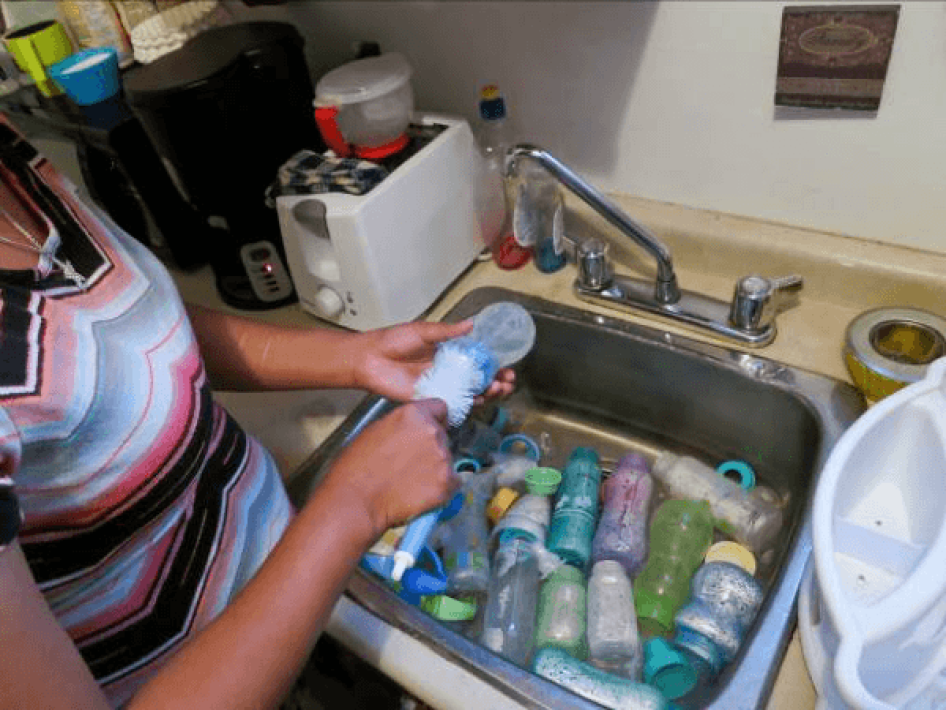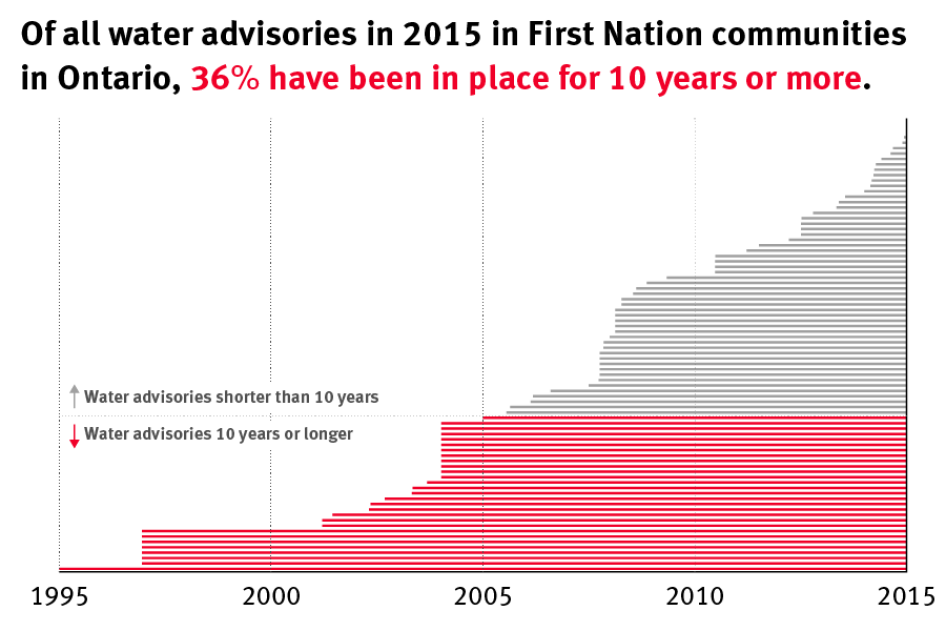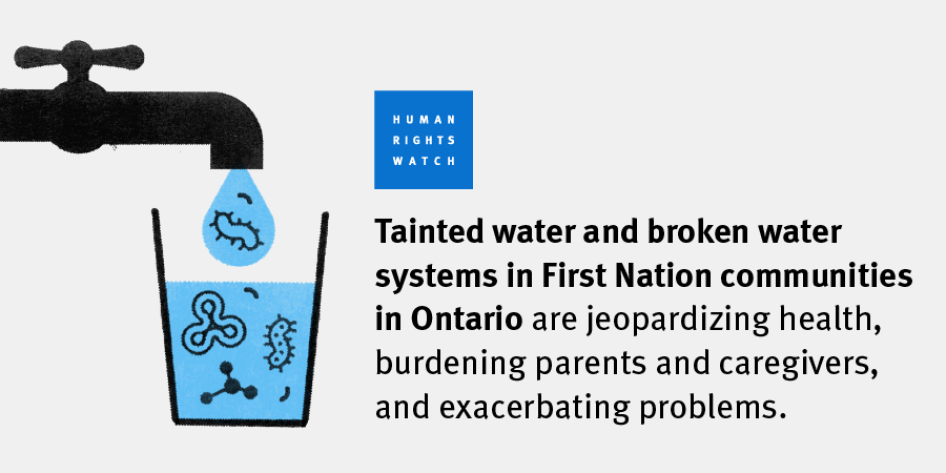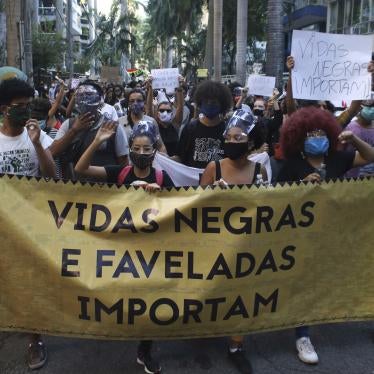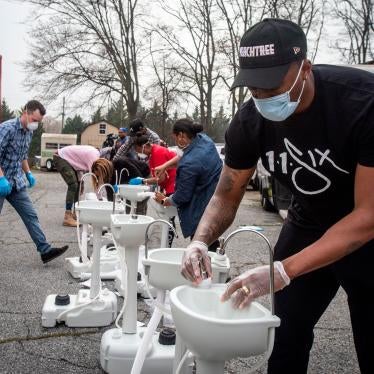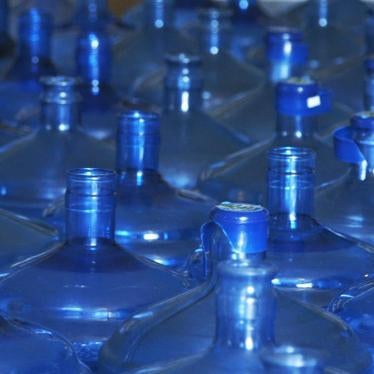(Toronto) – Canada has abundant water, yet water in many indigenous communities in Ontario is not safe to drink, Human Rights Watch said in a new report today. The water on which many First Nations communities in Canada, on lands known as reserves, depend is contaminated, hard to access, or toxic due to faulty treatment systems. The federal and provincial governments need to take urgent steps to address their role in this crisis.
“Tainted water and broken systems on Ontario’s First Nations reserves are jeopardizing health, burdening parents and caregivers, and exacerbating problems on reserves,” said Amanda Klasing, senior researcher at Human Rights Watch and author of the report. “First Nations people have the same human rights to adequate water and sanitation as all Canadians, but in practice cannot access them.”
The 92-page report, “Make It Safe: Canada’s Obligation to End the First Nations Water Crisis,” documents the impacts of serious and prolonged drinking water and sanitation problems for thousands of indigenous people – known as “First Nations” – living on reserves. It assesses why there are problems with safe water and sanitation on reserves, including a lack of binding water quality regulations, erratic and insufficient funding, faulty or sub-standard infrastructure, and degraded source waters. The federal government’s own audits over two decades show a pattern of overpromising and underperforming on water and sanitation for reserves.
Across Canada today, there are 133 advisories in place in 89 First Nations reserves warning that the water is not safe to drink. Most of them are concentrated in Ontario. These drinking water advisories – some in place for decades – represent the worst examples of systemic water and wastewater challenges facing First Nations in Canada. Canadian off-reserve communities have nowhere near this level of risk to their water; their systems are subject to regulations, and long-term water advisories are far rarer.

“As Human Rights Watch points out, we in First Nation communities must have what Canadians take for granted: safe water and proper sanitation,” said Ontario Regional Chief Isadore Day. “Although there has been some progress and lots of promises, there are far too many Indigenous people still living – and dying – in poverty in this country today.”
As part of its research, Human Rights Watch conducted a survey of 99 households, home to 352 people, in five First Nations communities in Ontario, and 111 qualitative interviews. The report analyzes data from government sources on water and wastewater assets, budget allocations, and water advisories. In total, Human Rights Watch compiled government data for 191 water systems among 137 communities belonging to 133 distinct First Nations in Ontario.
Human Rights Watch found that the water crisis on reserves decreases the quality and quantity of water available for drinking and hygiene. Many households surveyed by Human Rights Watch reported problems related to skin infections, eczema, psoriasis, or other skin problems that they believed were related to or exacerbated by the water conditions in their home.
Many respondents said that federal departments or First Nations authorities had alerted them to contaminants in their water, including: coliform, Escherichia coli (E. coli), cancer-causing Trihalomethanes, and uranium. Negative health consequences from exposure to such contaminants can range from serious gastrointestinal disorders to increased risk of cancer.
Tainted water and broken systems on Ontario’s First Nations reserves are jeopardizing health, burdening parents and caregivers, and exacerbating problems on reserves. First Nations people have the same human rights to adequate water and sanitation as all Canadians, but in practice cannot access them.
Senior researcher, women's rights division
Families reported changing hygiene habits, including limiting baths or showers for children, based on concerns about water quality. Caregivers shouldered extra burdens to ensure that children, elders, and others avoided exposure to unsafe water.
The federal government, which has jurisdiction over reserves, has not taken appropriate action to ensure that residents on First Nations reserves benefit from equal protection before the law. While off-reserve communities benefit from binding water quality regulations, there are no enforceable water regulations on reserves.
The federal government, which provides financial support for First Nations water systems for design, construction, operation, and maintenance, has funded and advised on design for systems on First Nations reserves that fell below the standards that applied in neighboring communities. Some of these water systems were soon placed under water advisories, including some within two years of construction. An additional one in five people in Ontario on reserves get their water from private wells, many that are also contaminated.
“The water crisis is the result of years of discrimination compounded by lack of accountability,” Klasing said. “And it is First Nations families who are exposed and worrying about whether the water they drink and bathe in will do damage to their kids. The government of Canada needs to tackle both the symptoms and the underlying causes.”
Canada’s Obligation to End the First Nations Water Crisis
In March 2016, the Trudeau government announced new commitments and funds to bring the water and wastewater systems in First Nations communities up to the standard of comparable communities off reserve within five years. This is a positive sign – but it is not the first time the government has pledged money to fix these problems. Past investments involving billions of dollars failed to remedy systemic problems with water and wastewater on reserves. They were erratic and plagued by arbitrary allocation formulas, failure to spend available funds, and rigid caps that ignored population growth, uneven resources, and differences among reserves. The current government should learn from past failures, and meaningfully engage with First Nations as it works to make good on its promises.
“Despite significant investments in the sector, the Canadian government has failed to bring the water and sanitation conditions on reserves up to the standards most Canadians enjoy,” said Klasing. “Funding alone does not indicate success.”
The crisis also impacts the cultural rights of First Nations communities. Their water ceremonies, customary fishing and hunting practices, and ways of teaching children and sharing traditional knowledge about water are impacted when water is contaminated. International law recognizes indigenous peoples’ right to maintain and strengthen their spiritual relationship with traditionally owned or occupied lands, territories, waters, and other resources, and to uphold their responsibilities to future generations.
Moreover, source waters for First Nations water supply are increasingly degraded by industrial activities, agricultural run-off, and waste-disposal practices off reserves, yet First Nations leaders said that the provincial and federal governments have not involved them in source water management.
“Generations of residents on First Nations reserves have grown up without clean or safe drinking water,” said Klasing. “The new government has said it is committed to change. Now it is time to act.”
Tweet for Rights
Selected Testimonies:
Debora C., a woman in Grassy Narrows First Nation, explained how difficult it was to manage her 9-year-old son’s recurrent rash: “I kept taking him to the clinic and they kept saying it was eczema. His belly and buttocks got really red, oozy, and it spread. The ointment [they gave me] didn’t work. I took him again.” Finally, her son was diagnosed with a skin disease that resists most antibiotics. She cannot bathe him in the tap water in her home, and uses bottled water in large jugs:
I sponge him with bottled water from the jugs, clean him that way.... My son has scarring now from where the rash broke out. [It’s] not inflamed now… But he will have an inflammation once in a while, it won't go away [totally] because of the water…My kids miss one day, bathe every two days. If my son has a cut, [it] will turn into a rash and I have to take him to the clinic to take antibiotics. So, my son misses a lot of school.
Walter S., a father-of-four in Neskantaga First Nation – three under the age of three – reported that members of his family were diagnosed with scabies last year. He believes that the sores were related to the water, because the medicine his family received from the health center had not worked. “It’s hard to tell the one-year-old and nine-month-old not to scratch. It’s hard to be the bad guy about it all.… My oldest hides in the bathroom to itch.”
Stacey K., mother of an 11-month-old baby in Neskantaga First Nation, reported:
When [my son] was a newborn, I would use water from the [reverse osmosis dispenser], but it was hard to bathe him every day. So I use the tap water. When he was 4 months old, his face got swollen. [I was told] he has eczema. I want to bathe him every day, but it has to be every two to three days. [When we travel to] Thunder Bay, his skin isn’t like this [when I bathe him in the water there].
Linda R., a mother in Shoal Lake 40 First Nation, said her foster son had a recurring rash, and she kept taking him to the doctor.
“On the fourth or fifth time I went in, [the doctor] asked me ‘do you have treated water in your community?’ I said, ‘no we don’t.’ ‘Well, there’s your problem,’ he said.”
